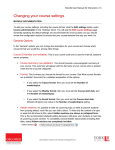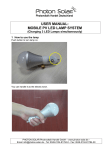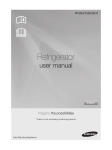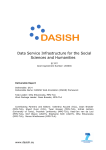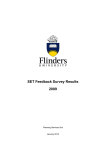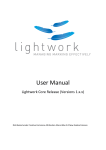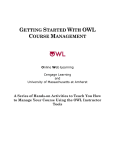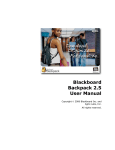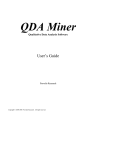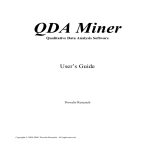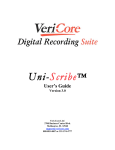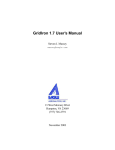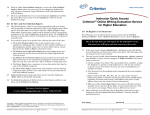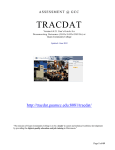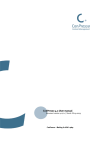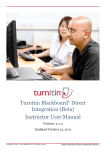Download 1. About The Help Pages 2. Getting Started 2.1
Transcript
Lightwork 1 of 85 http://127.0.0.1:2944/help/advanced/print.jsp?topic=/nz.ac.massey.ligh... 1. About The Help Pages 2. Getting Started 2.1. Installation of Lightwork on Your PC 2.2. Setting Up and Connecting to Your Moodle Site 2.3. Where to Find More Help 3. Concepts 3.1. To Be Done in Moodle before Using Lightwork 3.2. Moodle Assignment Types to be Used with Lightwork 3.3. Lightwork User Types Marking Manager and Marker 3.4. Lightwork Data Types and Exchange with Moodle 3.5. Assignment Status and Interactions between Marking Manager and Markers 3.6. How to Mark in Lightwork 3.7. Introduction to Marking Rubrics 3.8. Types of Marking Rubrics 3.9. Allocation of Markers 3.10. Taking Advantage of Turnitin's Similarity Checking 3.11. Main Steps of Working with Lightwork 3.12. Principles of Using the Lightwork User Interface 4. Management Perspective 4.1. Looking at Course, Assignment and Student Listings 4.2. Creating an Analytic Marking Rubric 4.3. Creating a Holistic Marking Rubric 4.4. Modifying a Marking Rubric 4.5. Setting a Marking Rubric Ready for Marking 4.6. Creating a PDF File for Marking Rubric 4.7. Uploading a Marking Rubric PDF File to Moodle 4.8. Allocating Markers 4.9. Monitoring Progress 5. Marking Perspective 5.1. Downloading Student Assignment Files 5.2. Marking of Student Work 5.3. Monitoring Ones Own Marking 5.4. Annotating Student Work Directly 5.5. Lightwork PDF Annotator 6. Release Perspective 6.1. Monitoring the Progress of Marking 6.2. Reviewing the Work of the Markers 6.3. Applying Penalties 6.4. Releasing Marking Results to Moodle 6.5. Exporting Marking to Spreadsheet File 7. For Quick Reference 8. Moodle Team Assignment Activity 8.1. Teacher Perspective of a Team Assignment 8.2. Student Perspective of a Team Assignment 9. Glossary 22/12/2010 2:01 p.m. Lightwork 2 of 85 http://127.0.0.1:2944/help/advanced/print.jsp?topic=/nz.ac.massey.ligh... Lightwork is a new application for the management and marking of assignments. In addition to making the process of working with assignments more efficient, Lightwork aims at encouraging good marking practices. Lightwork is designed to work in conjunction with Moodle. It builds on the assignment functionality Moodle offers and adds features that help with the marking tasks. Lightwork contains the following main features: Downloading of course, students and assignment data from Moodle; Definition of Marking Rubric by teacher Allocation of marking to multiple Markers; Creation of marking sheets based on Marking Rubric for each student assignment; Dealing with any type of student work and viewing this work in associated applications; Entering of feedback and marks linked into marking sheets by Markers; Writing and applying of frequently used comments, associated with Marking Rubric, by marking team; Support for teacher in monitoring work of Markers; Presentation of marking feedback to students linked to Marking Rubric; Automated upload of marks, marking feedback and annotated student work to Moodle; Automated refreshment of data from Moodle; Options of working online or offline. Lightwork is an application that runs on the user’s PC. It connects to the institution’s Moodle installation and works together with the assignment module and Gradebook in Moodle. The students still submit their assignment work to Moodle and receive their marks and feedback via Moodle. The students do not interact with Lightwork directly. After having setup the assignment specification in Moodle, the teacher works in Lightwork to manage the marking and to perform the marking tasks. One aspect of Lightwork is to support marking teams, where one person might be in charge of leading several Markers. Typical tasks of the person in charge will be to define the marking criteria, to decide who is marking which student assignments, and to oversee the quality of the marking. Usually a teacher will fulfil this role and might be leading a team of casual assistants who are employed for marking. The Lightwork manual uses the terms 'Marking Manager' when talking about the leadership role in the marking team, 'Marker' 22/12/2010 2:01 p.m. Lightwork 3 of 85 http://127.0.0.1:2944/help/advanced/print.jsp?topic=/nz.ac.massey.ligh... when referring to the marking role, and 'user' when in general terms talking about the person working with Lightwork. In courses with small student numbers the teacher is likely to work by themselves, fulfilling both the management and marking roles. This is what is depicted in Figure 1 that focuses on the distinction between students and teachers in regard to Lightwork. How students and teachers interact with Moodle and Lightwork Working with Lightwork is – at least in the opinion of the Lightwork team – not difficult. Yet, this type of e-learning software is relatively new and therefore there are a few concepts you might not be familiar with. The Lightwork team suggests that you read through this manual to familiarise yourself with how Lightwork works and gain confidence that it is not only a helpful tool but also trustworthy for dealing with an issue as critical as assessment. The pedagogy behind Lightwork Lightwork has been designed based on educational theories about assessment and marking. Throughout the help pages you will find information on how to use Lightwork to support good marking practices. Licence The Lightwork help pages/user manual are distributed under a Creative Commons Attribution-Share Alike 3.0 New Zealand Licence. These help pages work in progress. While the Lightwork team attempts to update these pages for new versions of Lightwork this will not always happen immediately. The help pages have been written with focus on the conceptual aspects of Lightwork. Status of the help sections: Section Status Getting Started Updated for Lightwork 2.3.2 Concepts Updated for Lightwork 2.3.2 Management Perspective Updated for Lightwork 2.3.2 Marking Perspective Updated for Lightwork 2.3.2 Release Perspective Updated for Lightwork 2.3.2 For Quick Reference Updated for Lightwork 2.3.2 22/12/2010 2:01 p.m. Lightwork 4 of 85 http://127.0.0.1:2944/help/advanced/print.jsp?topic=/nz.ac.massey.ligh... Moodle Team Assignment Activity Glossary Updated for Lightwork 2.3.2 Updated for Lightwork 2.3.2 Via the print dialog the help pages can be exported into one document. The Lightwork help pages are distributed under a Creative Commons Attribution-Share Alike 3.0 New Zealand Licence. Lightwork is an open-source application that works in conjunction with the Moodle learning management system. Lightwork supports the management and marking of assignments. The following sections explain how to install Lightwork on the your PC and how to connect to your Moodle site. It is recommended that you familiarise yourself with the Lightwork concepts. For installation you need to download Lightwork to your PC. The site http://lightworkmarking.org/ leads you to the Lightwork files for the newest stable version of Lightwork. Via the Files section of the Lightwork development site you can access any version of Lightwork. You might want to check with your Moodle site administrator which version of Lightwork you should use. Download the version of Lightwork for your operating system (Windows, Mac, Linux) and run the installer file. The Lightwork installer creates shortcuts/Start menu entries for starting the Lightwork application. Data required for working with Lightwork are stored in your home folder on your PC. Within this folder two Lightwork folders are created: lightwork: For all student assignment files downloaded from Moodle; lightworkdb: For all data created within Lightwork, for example the Marking Rubric 22/12/2010 2:01 p.m. Lightwork 5 of 85 http://127.0.0.1:2944/help/advanced/print.jsp?topic=/nz.ac.massey.ligh... specifications or the Marker allocations. Your home folder location is normally at: Windows: C:/Documents and Settings/your_username Macintosh: Users/your_username Linux: \home\your_user_name Protection of student assignment files Lightwork downloads the students' assignment files to your PC. You open these files directly via the Lightwork user interface. As these files are stored within your home folder access should be restricted to you. If you share your login details with someone else please be aware that this person would then have access to the student assignment files. Lightwork connects on your behalf to your Moodle site to access course, student and assignment details. Setting up the Moodle connection and connecting Lightwork to Moodle are two separate steps. You provide the details for setting up the Moodle connection only once and re-use these details every time when using Lightwork for opening the connection to Moodle. Your Moodle site will normally be the Moodle installation maintained by your institution. Lightwork can only connect to this Moodle installation if this installation has been extended for use with Lightwork. Please check with your Moodle administrator if this is the case (for access to Moodle test data see information below). You need to provide Lightwork with the details required for this connection: Server address: The web address of your institution’s Moodle site (the http address you use when connecting to your Moodle site via your web browser); Username and password: The details you provide when you login to your Moodle site. Additionally, Lightwork asks you for a name of your choice for these connection details. Lightwork remembers the connection details under this name. Most users will only connect to one Moodle site. Some users will connect to several Moodle sites, for example, to a production and a test site at their institution, or when marking for more than one institution. Lightwork can store several connection details and the user can choose from these for connecting to Moodle. 22/12/2010 2:01 p.m. Lightwork 6 of 85 http://127.0.0.1:2944/help/advanced/print.jsp?topic=/nz.ac.massey.ligh... In the top left hand corner of the Lightwork application window you find the Moodle menu. The Moodle menu provides you with several options related to connecting to Moodle: Define Moodle Connection Set up new Moodle connection Open Moodle Connection Open a Moodle connection Edit Moodle Connection Change details of a Moodle connection Delete Moodle Connection Delete connection details Refresh Moodle Connection Exchange data between Lightwork and Moodle The menu option 'Refresh Moodle Connection' triggers an exchange of data between Moodle and Lightwork. You typically will exchange data at the start of a work session, in the middle to copy work done locally to Moodle and at the end of a session. Select the 'Define Moodle Connection' option and provide the parameters for the connection to your Moodle site. Name: The name you wish to call your Moodle connection Server address: The address of your server that hosts your Moodle site Username: Your Moodle username Password: Your Moodle password Fill in the details and click OK. This will prepare a new Moodle connection to the server you have specified. You have to do this step only once for a connection to a Moodle server. From there on the connection details are stored in Lightwork. You can now use the option 'Open Moodle Connection' from the Moodle menu to establish the connection between Lightwork and Moodle. Select the Moodle connection you wish to use. You will be prompted for your password. Lightwork will connect to the selected Moodle site using the specified username. After a brief delay you will see a window showing progress information. 22/12/2010 2:01 p.m. Lightwork 7 of 85 http://127.0.0.1:2944/help/advanced/print.jsp?topic=/nz.ac.massey.ligh... Connecting for the first time to a Moodle site can take up to a few minutes. Subsequent refreshing of data will be faster (with the duration depending on your network speed, the Moodle server speed, the number of courses you have access to and the number of students enrolled in these courses). If the connection to Moodle has been successfully established the name you have chosen for your connection will appear in the top border of the Lightwork application window. If the connection to Moodle fails an error message will be displayed. You should check if your connection details and password are correct and if your have a live network connection or if the Moodle site is running. If you are crossing a network firewall from Lightwork installed on your PC to the Moodle installation you want to access, you have to make the appropriate proxy server settings. From the Tools menu select Preferences and Proxy Server. Ask your institution's network administrator for the values you have to enter. On the Lightwork home page http://lightworkmarking.org/ you will find additional material about Lightwork. This material includes narrated screen recordings, information on how to use Lightwork from an educational perspective and an evaluation report on using Lightwork in tertiary education institutions. The following sections explain the main concepts behind Lightwork. Reading these sections is important for understanding how Lightwork supports marking teams and how it interacts with Moodle. Lightwork complements Moodle. This implies that everything that is already covered well by Moodle functionality is continued to be done in Moodle and that Lightwork focuses on additional functionality. Moodle already has the functionality for setting up assignments. This contains specifying a name and description for an assignment, and providing values such as due date and 22/12/2010 2:01 p.m. Lightwork 8 of 85 http://127.0.0.1:2944/help/advanced/print.jsp?topic=/nz.ac.massey.ligh... maximum number of marks available. Lightwork expects that you have already setup your assignments in Moodle. For help on how to do this please refer to the Moodle user documentation. If you are a marker on a course the teacher responsible for the course should have setup the assignment already. Students submit their work to Moodle. After the marking in Lightwork the marking results are returned to Moodle. Students can see their assignment marking in the same way as if it would have been entered directly via the Moodle user interface. The assignment marks will show in the Moodle GradeBook. Among the assignment types provided with Moodle it is recommended to use the 'Advanced uploading of files'. With the installation of Lightwork on your Moodle site and additional assignment type, called 'Team Assignment', should have been included. The Team assignment type has been developed by the Lightwork project. In a team assignment students use the Moodle user interface to setup teams and who belongs to a team. When one team member submits work for the team assignment all team members instantly get access to this work. marking of a team assignment happens on team level. All members of a team receive the same marking results. Using the team assignment type has the advantages that both Moodle and Lightwork know which students have worked together. Students can see work submitted on their behalf. Teachers do not have to reconcile team membership and submissions manually. Marking results are available to all team members. Regardless which assignment type you choose, you have to select a numeric grade (between 1 and 100) for your assignment. Extensions to Lightwork are planned (for Versions after 2.3) that will allow working with non-numeric and self-defined scales. Educational Perspective There are two main ways for grouping students for working together in teams on assignments. First, is left to students to decide with whom they want to work together. The teacher might give an instruction like 'You can submit this assignment by yourself or together with one or two other students'. Second, The teacher might choose the composition of teams. In this case the teacher might provide students with a list showing the composition of teams. Both ways are compatible with the team assignment module. Students setup their teams, based on their own selections or guided by the instructions by 22/12/2010 2:01 p.m. Lightwork 9 of 85 http://127.0.0.1:2944/help/advanced/print.jsp?topic=/nz.ac.massey.ligh... the teacher. The teacher can see which teams have been formed both in Moodle and in Lightwork. At this stage the teacher cannot change the team memberships. Should a student be in the wrong team the teacher has to communicate this to the student or the team concerned. The design of the team assignment type centres around the assumptions that all team members have access to all files submitted by team members and that all team members receive the same marking feedback (with the exception of penalties that can be applied individually). Should you want to assess components of student work individually the recommendation is to setup two assignments in Moodle. One assignment will be for the shared work by all team members, the other assignment for the individual contributions. Lightwork has two user types called Marking Manager and marker who have different capabilities in Lightwork. The Lightwork Marking Manager carries out the following tasks: Setting up of the marking rubric; Deciding who marks which assignments; Monitoring the quality of the marking; Releasing marking results to students. The Lightwork Marker marks assignments. This user cannot carry out the tasks of the Marking Manager. The Marking Manager can as well mark assignments. This is the case if the Marking Manager assigns assignments to themselves and for these assignments takes on the role of a Marker. The Marking Manager should be the person in charge of the respective course and assignment. As part of the configuration of your Moodle site for working with Lightwork your Moodle administrator needs to create a mapping between Moodle roles and Lightwork capabilities. Please check with your local Moodle administrator how this mapping has been done. Educational Aspects: Composition of marking teams The way marking teams are composed depends on institutional and course contexts. Sole teacher: One person is responsible for the assignment and does all the marking. 22/12/2010 2:01 p.m. Lightwork 10 of 85 http://127.0.0.1:2944/help/advanced/print.jsp?topic=/nz.ac.massey.ligh... This person has the Lightwork capability of Marking Manager, meaning the person can perform the management and releases tasks and can do the marking. Teacher and assistants: One teacher is in charge of the assignment. This teacher has the Lightwork capability of Marking Manager and carries out the management and release tasks. The assistants have the Lightwork capability of Marker and perform the actual marking. Two teachers: Two teachers work together on marking an assignment for which they are both in charge. Both teachers have the Lightwork capability of Marking Manager. The teachers share the tasks of the management and release tasks and both mark student work. Administrator, teacher and assistants: The administrator and teacher both have the Lightwork capability of Marking Manager. They share the management tasks. For example, the teacher creates the Marking Rubric and releases the marking results after having performed some quality control. The administrator allocates Markers and monitors progress. The assistants have the Lightwork capability of Marker and perform the actual marking. This section of the Lightwork manual explains the data types Lightwork uses to work together with Moodle. It is important for the Lightwork user to understand this as it affects how to access student assignments and the online/offline working options. Lightwork is designed to complement Moodle. Lightwork builds on the data already available in Moodle, for example, the courses defined and the students enrolled in these courses, and adds its own data, for example, the details of a Marking Rubric and the allocation of Markers to student assignments. The design of Lightwork also considers that some Lightwork users will only have a slow Internet connection available to them and that the Lightwork user will not always be connected to the Internet. Data Types Three types of data can be distinguished: Moodle data: Data available in Moodle that are of a relatively small size Course details Students enrolled in a course 22/12/2010 2:01 p.m. Lightwork 11 of 85 http://127.0.0.1:2944/help/advanced/print.jsp?topic=/nz.ac.massey.ligh... Assignments specified for the course Dates for student assignments submitted Student assignment files: Data that are potentially of a large size The assignment files the students have submitted, e.g., word processing files, spreadsheet files, presentation files The student assignment files the user has annotated with marking comments, e.g., by using Word track changes or Adobe PDF comments Lightwork data: Data created by Lightwork Marking Rubric definition Marking allocation Marking information The reason for treating student assignment files differently from other assignment data is that these files can combine to a large file size, for example if the number of students in a class is very high or if the individual assignments are very large. Lightwork does not automatically download the student assignment files to the user’s PC, but waits for the user’s explicit instructions. The section on downloading student work under Marking Perspective shows how this is done. This mechanism can be helpful in the following circumstances: If the user is a Marking Manager and does not need to download all student assignment files for the whole class. If the user wants to perform the download at a time convenient to them, e.g., just before going on a break, when a delay caused by a slow network connection will not be a problem. Data Exchange The Moodle data and Lightwork data can be exchanged between Moodle and Lightwork as soon as a connection is established. While working with Lightwork the user can trigger an exchange of Moodle data and Lightwork data by using the Moodle menu option Refresh Moodle Connection. Lightwork keeps local copies of all data – the Moodle data, the student work and the Lightwork data – on the user’s PC. This enables the Lightwork user to work offline if no Internet connection is available. Once the Lightwork user has downloaded the data 22/12/2010 2:01 p.m. Lightwork 12 of 85 http://127.0.0.1:2944/help/advanced/print.jsp?topic=/nz.ac.massey.ligh... required from Moodle the actual marking work can happen offline. Once the network connection becomes available again the user connects their Lightwork to Moodle and the exchange of data takes place. The other aspect of data storage and exchange is how the members of a marking team communicate with each other about the work they do on their individual PCs in Lightwork. Exchange is required for the Marking Manager to pass on the Marking Rubric to the Markers and for the Markers to pass on their marking work to the Marking Manager. The mechanism used to achieve this centres around a special Lightwork data space located in Moodle. The Lightwork application on the PC of a user A can put Lightwork data in this Lightwork data space in Moodle. The Lightwork application on the PC of a user B can take this data from there. This mechanism allows Lightwork users belonging to one marking team to work together conveniently, without having to exchange data through other means like email or memory sticks. The diagram below displays this arrangement. Diagram: How different Lightwork users communicate via a special Lightwork data space in Moodle The mechanism of exchanging data among different Lightwork users is also helpful to an individual user who wants to work on different PCs. For example, the user can start marking on their notebook. After connecting Lightwork to Moodle and exchanging data the user can then continue to work on their office PC as all data can be downloaded to this 22/12/2010 2:01 p.m. Lightwork 13 of 85 http://127.0.0.1:2944/help/advanced/print.jsp?topic=/nz.ac.massey.ligh... computer. One important question when marking is about student access to the marking results and feedback. When working with Lightwork the teacher has control over when the students gain access. This is explained in detail in the section on releasing marking results in the Release Perspective. In brief, students only get access if the Lightwork user explicitly releases the marking. Before this is done the Lightwork data containing the marking results and the feedback are only stored in the special Lightwork data space located in Moodle. A student cannot access these data. Lightwork controls the work flows around assignment marking via statuses. The status of the work students have submitted controls the activities that can be executed by the marking manager and the markers. The following diagram shows the statuses and the main transitions between these statuses. There are two major workflows, one associated with a marker, the other with the marking manager. Marking 22/12/2010 2:01 p.m. Lightwork 14 of 85 http://127.0.0.1:2944/help/advanced/print.jsp?topic=/nz.ac.massey.ligh... Once an assignment has been allocated to a marker, the marker starts by changing the status of the assignment to 'In Marking'. This status change signals to the marking manager that the marker is working on the assignment. The marker marks the assignment and once this is done sets the marking status to 'Marking Finished'. This status change helps the marker to get an overview on which assignments are completed and which still need to be marked. This is information used only by the marker. At any time the marker can reverse the status to 'In Marking' to make changes to the marking. Once the marker is satisfied that an assignment is completely marked they pass this assignment on to the marking manager by changing its status to 'In Review'. The marker now cannot make further changes to the marking. Review of Marking and Release to Moodle The marking manager looks at the assignments with status 'In Review'. These are the assignments that have been passed on by the markers. Three pathways are possible. 1. The work a marker has done is acceptable without change. The marking manager sets the assignment to 'Ready for Release'. 2. The marker needs to make some changes to the marking. The marking manager returns the assignment to the marker by putting it back into the status 'In Marking', still allocated to the same Marker. 3. Changes are required to the marking but are to be done by a different marker. The marking manager reallocates the assignment to a new marker, returning it to the status 'Allocated'. The newly assigned marker will build on the marking of the original marker. The release of marking to Moodle (and therefore to students) follows on from the assignments that have been given the status 'Ready for Release'. Typically, the marking manager will first review the work by all markers before releasing all satisfactory marked assignments to Moodle by setting the status of these assignments to 'Released'. It is important to note that once the marking for an assignment has been released this cannot be taken back (yet new releases to make changes are possible). If the marking manager wants to make changes to marking done by a marker, the marking manager has to reallocate the assignment to themselves first. Further Workflows to Fix Problems The two main work flows described above will be what are mainly used. Yet, as problems can occur (e.g., when a marker unexpectedly becomes unavailable in the middle of 22/12/2010 2:01 p.m. Lightwork 15 of 85 http://127.0.0.1:2944/help/advanced/print.jsp?topic=/nz.ac.massey.ligh... marking) Lightwork provides some additional transitions between the statuses of assignments (these transitions are not shown in the diagram). The marking manager can de-activate marking that has been put into the 'In Review' status. The marking manager can reallocate marking that has 'In Marking' status. In this case the newly allocated marker starts with an empty marking sheet. The marking manager can reallocate marking that has 'Marking Finished' status. In this case the newly allocated marker continues with the data already entered in the marking sheet by the previous marker. Lightwork keeps the history information for each assignment and its marking status changes. Marking with Lightwork is based on recommendations found in the literature on assessment. Marking rubrics are at the centre of these recommendations. Emphasis is put on providing formative feedback to students that helps students to understand what is good or not so good about their work and shows them ways towards improvement. Marking should be consistent, both within a marker and across the members of a marking team. The first step for marking in Lightwork consists of creating a marking rubric (some people use the terms marking scheme or marking schedule). A marking rubric defines the criteria by which to assess student work. A marking rubric is linked to a specific assignment and has to be defined before marking can commence. The purpose of a marking rubric is to show students what is expected of their work and how this work will be assessed. The marking rubric guides the markers in assessing student work and in providing feedback to students. The marking rubric can be seen as a template. For each student a copy of this template is made. This copy is called a marking sheet and is specific to a student and their assignment work. The marker enters marks and feedback into the marking sheet. In addition to filling out a marking sheet for each student the marker can annotate student work directly with inline comments. Lightwork supports this by facilitating the creation of a copy of the student work and by automatically uploading annotated student work to Moodle for return to the student. The annotation of the student work can be done either in a program external to Lightwork, such as a word processor, or in Lightwork's own PDF Annotator. 22/12/2010 2:01 p.m. Lightwork 16 of 85 http://127.0.0.1:2944/help/advanced/print.jsp?topic=/nz.ac.massey.ligh... On release of marking from Lightwork to Moodle the marking sheet is uploaded to Moodle in PDF format. The annotated file, if one is used as part of the marking process, is also uploaded. In addition the overall mark given to the student is returned. A standard textual comment, which can be edited by the teacher, refers the student to the marking sheet. When working with a team assignment the same principles apply. The difference is that the marking sheet and the annotated document apply on team level. For each student team there is one marking sheet. Each team member receives a copy of the marking sheet and of any annotated documents. It is possible to give different total marks and different release comments to the team members. This might be relevant if, for example, it comes to the attention of the teacher that one student has not contributed to the degree required in the work the team has submitted. A marking rubric defines the criteria by which to assess student work. A marking rubric is linked to a specific assignment and has to be defined before marking can commence. Lightwork supports two types of marking rubrics, called analytic marking rubric and holistic marking rubric. The work on the marking rubric is undertaken by the marking manager. For each assignment in a course there is one marking rubric. 22/12/2010 2:01 p.m. Lightwork 17 of 85 http://127.0.0.1:2944/help/advanced/print.jsp?topic=/nz.ac.massey.ligh... The purpose of a marking rubric is to show students what is expected of their work and how this work will be assessed. The marking rubric guides the markers in assessing student work and in providing feedback to students. The marking rubric can be seen as a template. For each student work a copy of this template is made. This copy is called a marking sheet and is specific to a student and their assignment work. The marker enters marks and feedback into the marking sheet. The diagram displays the relationship between marking rubric and marking sheets. In addition to the criteria with their descriptions and marks the Lightwork marking rubrics allow for two further, optional elements. The marking manager can include instructions to markers. These instructions are specific to each criterion and allow the marking manager to pass on details important for consistent and high quality marking. The students will not be able to see these instructions directed at the markers. The marking manager can include comments that are likely to be required for commenting on the work of many students. These comments are attached to specific criteria. They can be inserted into marking sheets by the markers. Well thought out comments can speed up the marking process, increase the quality of feedback and help with consistency across the marking team. In Lightwork these pre-defined comments are called 'frequently used comments'. Lightwork supports is two types of marking rubrics, called analytic marking rubric and holistic marking rubric. Both types of marking rubrics build on criteria. Lightwork provides the mechanisms for defining criteria. It is up to the teacher in charge of the assignment to determine what these criteria are based on the learning goals for the assignment. 22/12/2010 2:01 p.m. Lightwork 18 of 85 http://127.0.0.1:2944/help/advanced/print.jsp?topic=/nz.ac.massey.ligh... Analytic Marking Rubrics In an analytic marking rubric there is a description for each criterion and a maximum number of marks available for this criterion. The maximum number of marks for each criterion needs to add up to the total number of marks available for the assignment, as specified in Moodle. It is up to the teacher in charge to decide how fine-grained the marking rubric is. For some assignment contexts rubrics with many very specific criteria are suitable, for other contexts a few criteria on more conceptual levels are better. In addition to criterion name, description and maximum mark further information can be specified for each criterion. Guidelines directed at markers can be entered to allow the teacher in charge to pass on detailed information about how to mark to the markers. Predefined comments, called frequently-used comments in Lightwork, can be attached to each criterion to help markers to give good quality feedback efficiently. An example for a criterion called 'Referencing' might look as follows. Name Description Maximum mark Referencing You are expected to support your arguments with high quality and relevant references. Use APA style to present your references. 10 There should be at least 5 references to journal articles. The references Guidelines for must support the main points made. Take off up to 3 marks if APA is not markers correctly applied. Provide feedback to outline which aspects of APA are violated. 22/12/2010 2:01 p.m. Lightwork 19 of 85 http://127.0.0.1:2944/help/advanced/print.jsp?topic=/nz.ac.massey.ligh... You have provided relevant references. APA formatting is applied correctly. Frequently-used comments You mainly reference web pages. Look for references to journal articles. Examples of relevant references would have been (James, 2002) or (Miller, 2004). APA referencing requires the year of publication. APA referencing requires the place of publication. For the marking Lightwork creates a copy of the analytic marking rubric for each student (or team of students). For each criterion the marker decides on a mark that is between zero and the maximum mark for the criterion. The marker places feedback for each criterion. This feedback can be based on a frequently-used comment or can be created independently by the marker. For an analytic marking rubric the marking manager can decide if the marks for the criteria are made visible to the student. With the default setting the PDF version of the marking sheet returned to the student will contain the overall mark and the marks associated with the criteria. If the marking manager selects not to show marks the marking sheet PDF will only contain the feedback but not the marks. In this case the student will see their overall mark or grade only via the Moodle interface, in the assignment page or the GradeBook. If this option is chosen the teacher might want to set the display in Moodle to showing grades instead of marks. Holistic Marking Rubrics In a holistic marking rubric levels of quality are described in addition to the criteria. The teacher in charge needs to decide how many quality levels are to be used and needs to describe what characterises work in regard to each criterion and quality level. What gets created is a matrix that has on one side the criteria and on the other side the quality levels. 22/12/2010 2:01 p.m. Lightwork 20 of 85 http://127.0.0.1:2944/help/advanced/print.jsp?topic=/nz.ac.massey.ligh... In constructing the holistic marking rubric the teacher has to decide how many marks are available for each criterion at each quality level. In addition, the teacher decides on a weighting for each criterion. The mark available for a criterion on the highest quality level multiplied by the weighting gives the maximum mark available for this criterion. The sum of the maximum marks available for all criteria has to match the mark available for the assignment as specified in Moodle. 22/12/2010 2:01 p.m. Lightwork 21 of 85 http://127.0.0.1:2944/help/advanced/print.jsp?topic=/nz.ac.massey.ligh... As for an analytic marking rubric guidelines for markers and frequently-used comments can be provided for each criterion of the holistic marking rubric. The example for a criteria called 'Referencing' might look as follows for a holistic marking rubric. Name Referencing For quality Description Mark Poor Basically no referencing. 1 Weak References do not support arguments well enough. 2 Ok levels Good Excellent Weighting References just support argument; APA structure is at least of acceptable level. References provide strong support for argument; 3 4 APA structure is at least of acceptable level. References provide strong support for argument; 5 APA structure is applied basically without flaw. 2 There should be at least 5 references to journal articles. The references Guidelines for must support the main points made. Take off up to 3 marks if APA is not markers correctly applied. Provide feedback to outline which aspects of APA are violated. You have provided relevant references. APA formatting is applied correctly. Frequently-used comments You mainly reference web pages. Look for references to journal articles. Examples of relevant references would have been (James, 2002) or (Miller, 2004). APA referencing requires the year of publication. APA referencing requires the place of publication. For the marking Lightwork again creates a copy of the holistic marking rubric for each student (or team of students). For each criterion the marker the quality level achieved by the student for the criterion. In addition, the marker places feedback for each criterion. This feedback can be based on a frequently-used comment or can be created independently by the marker. Setting up the marks for the quality levels and the weightings for the criteria requires some thought. The following examples, referring back to the 'Referencing' criterion, illustrate this. 22/12/2010 2:01 p.m. Lightwork 22 of 85 http://127.0.0.1:2944/help/advanced/print.jsp?topic=/nz.ac.massey.ligh... Minimum mark: The mark specified for 'poor' work is '1'. The marker can only select a quality level but cannot type a mark. This means that a student will at least get one mark for referencing, even if referencing has not been addressed at all. To make it possible to give no credit at all a quality level has to be introduced that has the mark '0' associated. Weighting: If the marker chooses 'good' as quality level for this criterion the mark awarded to the student will be '8'. This is calculated by multiplying the mark associated with the quality level, in this case '4', with the weighting for the criterion, in this case '2'. Granularity: Because the marker selects a quality level and the associated mark is multiplied with the weighting factor, the marks given to the student in this example can only be either '2', '4', '6', '8', or '10'. Finer grained marking can only be achieved be having more quality levels or more criteria. For example in this case, the teacher could think about splitting up the criterion 'Referencing' into two criteria that might be called 'Support of argument with references' and 'Application of APA style'. This would allow a finer grained mark allocation and might simplify the description of the quality levels, as the focus would be on only one aspect of the work for each criterion. On the other hand, with a very fine-grained rubric marking can get lost in detail. When using a holistic marking rubric the marking sheet PDFs that are returned to the students will not display marks. The students will see which quality level they have reached for each criterion. Student will see their overall marks or grades only via the Moodle interface, in the assignment page or the GradeBook. The teacher might want to set the display in Moodle to showing grades instead of marks. One of Lightwork's goals is to assist with the coordination of work done by the members of a marking team. In Lightwork marking can only take place once it has been specified who is marking whom. This is referred to as marker allocation. The marker allocation is carried out by the marking manager. Once a marker is allocated to a student the marker can start marking the work of this student. The marking manager can see who is allocated to mark which student and what status the marking is in. This allows the marking manager to monitor the progress of the marking work. Marker allocation can be done for individual or several students by selecting these students and then identifying a marker. Lightwork also contains several automated ways to allocate markers to all students in a course. In this case the allocation algorithm is selected and the markers are identified from the list of potential markers. 22/12/2010 2:01 p.m. Lightwork 23 of 85 http://127.0.0.1:2944/help/advanced/print.jsp?topic=/nz.ac.massey.ligh... Only Moodle users with the appropriate access rights in Moodle for the course the assignment belongs to can mark in Lightwork. Which user roles these are depends on the settings in your Moodle site. Typical roles would be Teacher and Non-Editing Teacher. The marker allocation has to be done even if only one person is marking in Lightwork. Only the allocated marker can mark a student's work. If the marking manager wants to edit the marking done by a marker they have to re-assign this student to themselves first. For team assignments a marker is assigned to the team and not to individual members of the team. Lightwork itself does not check for plagiarism. It leaves this task to providers like Turnitin who already cover this area well. If your institution has setup a connection between Moodle and Turnitin the following steps will happen for a Turnitin enabled assignment. Students submit their work to Moodle. Moodle sends off this work to Turnitin and receives similarity scores and links similarity reports back from Turnitin. As teacher you can see the scores and links for each student in the Moodle assignment interface. Like Moodle Lightwork provides you with access to the similarity scores and links to the similarity reports. These data are shown as part of the marking sheet belonging to a student or team. The following figure shows the main steps of working with Lightwork. You have to establish a connection to a Moodle site before you can execute these steps. 22/12/2010 2:01 p.m. Lightwork 24 of 85 http://127.0.0.1:2944/help/advanced/print.jsp?topic=/nz.ac.massey.ligh... The Marking Manager uses the Marking Perspective to create a marking rubric and to allocate markers to assignments. The marker allocation can only be done after a marking rubric has been created. Marking is only possible for students who have been allocated a marker. The Marker uses the Marking Perspective to download the student files for the assignments allocated to mark and marks these assignments. The Marking Manager uses the Release Perspective to monitor the quality of the marking and make the marking results available to students in Moodle. 22/12/2010 2:01 p.m. Lightwork 25 of 85 http://127.0.0.1:2944/help/advanced/print.jsp?topic=/nz.ac.massey.ligh... This section describes principles of the Lightwork user interface. These principles apply to all parts of Lightwork. Main Menu: Lightwork has a context sensitive menu. Moodle Tools Help Commands that deal with connecting to Moodle and exchanging data with Moodle. Access to preferences and the process of repairing inconsistencies between the Moodle and Lightwork databases. Information about Lightwork, access to the help system and checking for Lightwork upgrades. These menu entries are complemented by an entry for the active perspective. Perspectives: You can think of perspectives as different working contexts. Lightwork uses three perspectives. Management For the management of the marking, including the creation of marking rubrics and the allocation of markers. Marking For marking student work, including filling out the marking sheets. Release For quality control and the release of marking results to Moodle. You switch between perspectives by clicking on the perspective names Management or Marking or Release. Doing so you will see that the display in the Lightwork window changes. The three perspectives are always available but you can only see one at a time (the others are still there but hidden from view). 22/12/2010 2:01 p.m. Lightwork 26 of 85 http://127.0.0.1:2944/help/advanced/print.jsp?topic=/nz.ac.massey.ligh... Views: The Lightwork application window is divided into views. There are three types of views. Course listings Overview tables Editors Listing of courses, assignments and students you have marking access to in Moodle. Is specific to a particular assignment and shows all students, assignment submission dates and marking related information. Provide you with an interface for entering information. A course listing view always occupied the left portion of the Lightwork application window, the overview tables and editors are located on the right. Overview tables and editors can overlay each other. Access is then provided by tabs. The content of the views is dependent on which perspective is active. Tabs: Within the right view area several editors and an overview table can be open at the same time. These views will overlap each other. You switch between these views by clicking on the tabs that identify each view. You can close a view by clicking on the close icon. If there is unsaved information Lightwork will ask you if you want to save before closing. 22/12/2010 2:01 p.m. Lightwork 27 of 85 http://127.0.0.1:2944/help/advanced/print.jsp?topic=/nz.ac.massey.ligh... Changing the Layout: You can change the layout of the Lightwork interface in several ways. In the top right corner of a view you find icons you can click to minimise Minimising or or maximise a view. After clicking on these you will see a new icon that maximising views allows you to restore a view to its previous size. You can as well double-click on the tab of a view to maximise the view. Changing the size You can click and drag the dividing line between two views to expand of a view or its one view and make the adjacent view smaller. In some views there are internal space dividing lines between the panels that make up the view. You can modify allocation the size of these panels in relation to each other. Message area: Lightwork uses the lower border of the main application window to display messages to the user. 22/12/2010 2:01 p.m. Lightwork 28 of 85 http://127.0.0.1:2944/help/advanced/print.jsp?topic=/nz.ac.massey.ligh... Context menus: Especially in the course listings view you can right-click on items to reveal context sensitive pop-up menus. As alternative, you can just select the item and use the main Lightwork menu. Selection, dialog and message windows: Some commands you execute in Lightwork will make extra windows pop up. These windows will take you through a sequence of steps or will provide you with information. One common type are selection windows. Icons: Lightwork makes heavy use of various icons to communicate information to the user. Sometimes colour is used to indicate the status of an item. Tool tips: Many elements of the Lightwork user interface display tool tips if you hover with your mouse pointer over these items. 22/12/2010 2:01 p.m. Lightwork 29 of 85 http://127.0.0.1:2944/help/advanced/print.jsp?topic=/nz.ac.massey.ligh... Ideally a teacher would be able to focus just on the actual marking tasks, that is on providing feedback and marks. Reality shows that this is not the case and that teachers have many other tasks to perform in the context of assignment marking. Lightwork addresses some of these tasks in the Management Perspective; others in the Release Perspective. You can access the Management Perspective by clicking on its name. This section provides an overview of the tasks carried out in the Management Perspective. Creating a Marking Rubric: A marking rubric defines the criteria by which to assess the student work. A marking rubric has to be defined before marking can commence. In Lightwork a marking rubric can contain frequently used comments which can help with providing consistent and rich feedback to students. Lightwork offers support for both analytic and holistic marking rubrics. Allocating Markers: If there is a marking team it has to be decided which marker is going to mark which students. This allocation has to be done before marking can commence and has to be reviewed as the marking progresses. If only one person is marking then all students have to be allocated to this person as marker. Monitoring Progress: Providing students with timely feedback is important. It has to be monitored how the marking is progressing. 22/12/2010 2:01 p.m. Lightwork 30 of 85 http://127.0.0.1:2944/help/advanced/print.jsp?topic=/nz.ac.massey.ligh... In Lightwork these management tasks will be carried out by a Lightwork user who is assigned the Lightwork capability of marking manager. In a teaching context this should be a person in charge of the respective course and assignment. Lightwork restricts access to these management tasks to the marking manager. A Lightwork user with the Lightwork capability of marker cannot carry out these tasks. As part of the configuration of your Moodle site for working with Lightwork your Moodle administrator needs to create a mapping between Moodle roles and Lightwork capabilities. Please check with your local Moodle administrator how this mapping has been done. To facilitate the management tasks Lightwork provides the following user interface elements: The Course View: For listing courses, assignments and students; The Marking Management Table: For looking at allocations and at marking progress; The Marking Rubric Editor: For defining the marking rubric and the frequently used comments. While users with the Lightwork capability of marker do not have access to the management tasks they still get access to course, assignment and student lists and need to monitor their own marking process. Therefore Lightwork gives markers access to the Course View and the Marking Management View, but it restricts what these users can do within these views. The listing of courses, assignments defined for a course and students enrolled in a course is done via the Course View. Lightwork displays all courses for which the Lightwork user has marking access in Moodle. For each course the assignments specified in Moodle are 22/12/2010 2:01 p.m. Lightwork 31 of 85 http://127.0.0.1:2944/help/advanced/print.jsp?topic=/nz.ac.massey.ligh... displayed. For each assignment there is a document folder which is the place for the marking rubric that will be defined by the marking manager in Lightwork. For each assignment the students enrolled in the respective course are listed. By default, the Course View is located on the left in the Lightwork application window. This view cannot be closed, only minimised. It has a tree structure. Clicking on the +/- icons to the left of a folder expands and collapses the display of data. The Course View can be used to: Open the Marking Editor: By right-clicking on the Documents folder of an assignment or, if a marking rubric has already been defined, by double-clicking on the marking rubric name. Open the Marking Management View: By right-clicking on an assignment folder or by double-clicking on a student name (this highlights the entry for the student in the Marking Management View). Both marking manager and marker can open the Marking Management View. The data displayed in the Course View are refreshed from Moodle when Lightwork establishes a connection to Moodle and when the user selects the option 'Refresh Moodle Connection' from the Moodle menu. Restricting the Courses and Assignments of Interest Lightwork displays all courses and assignments the user has access to in the Course View. By default Lightwork refreshes data for all courses and assignments from Moodle. The user can tell Moodle if they are currently not interested in a particular course or assignment. This will mean that Lightwork will not be checking for updates on this course or assignment. The user can revert this setting at any stage. This option will be useful if a course or assignment is completed and no further work on it is required. 22/12/2010 2:01 p.m. Lightwork 32 of 85 http://127.0.0.1:2944/help/advanced/print.jsp?topic=/nz.ac.massey.ligh... Right-clicking on a course or assignment entry in the Course View shows the options 'Active/Inactive' that can be used to toggle the status. Inactive courses and assignments appear greyed-out. Before you create an analytic marking rubric please be sure that this is the right rubric type for your assignment. There can be only one rubric for each assignment. While you initially can delete a rubric this is no longer possible once you have set your rubric 'ready for marking'. Should you then discover that you have created a rubric of the wrong type you cannot change this. A new analytic marking rubric is created via Documents folder located under each assignment folder in the Course View. Select the Documents folder and activate its context menu or choose from the Management entry in the main Moodle menu. You have to be marking manager to be able to create and edit a marking rubric. You will be prompted to enter a name for the marking rubric. You can either start from an empty rubric or build on an existing rubric, if you have access to from other courses or assignments. To start from an empty rubric enter a name for the rubric. To start from an existing rubric select this option, select the existing rubric to build on and enter a name for your new rubric. If a marking rubric already exists you will see a rubric entry in the Documents folder. Open this rubric by double-clicking on its name or via the menu options. There can only be one rubric for each assignment. The analytic rubric editor has one area that shows all criteria defined for a rubric. The other two areas are specific to individual criteria. Information is shown in these areas if a criterion is selected. Please note that the rubric editor window is quite wide. You might have to use 22/12/2010 2:01 p.m. Lightwork 33 of 85 http://127.0.0.1:2944/help/advanced/print.jsp?topic=/nz.ac.massey.ligh... the scrollbar at the bottom of the editor window. An analytic marking rubric and its editor contains the following elements: Criteria for the rubric: For a new rubric you will see only one criterion called 'General Comment'. This criterion is there to provide overall feedback on the student work. You add your own criteria using the add button. You remove criteria with the delete button. You can change the sequence of the criteria with the up and down buttons. Once you have entered maximum marks for your criteria you will see these values listed besides the criteria names. The maximum marks for all criteria and must add up to the total possible mark you have set for the assignment in Moodle. 22/12/2010 2:01 p.m. Lightwork 34 of 85 http://127.0.0.1:2944/help/advanced/print.jsp?topic=/nz.ac.massey.ligh... Details for a criterion: Once a criterion has been added its details can be entered. These are the descriptions directed at students and markers and the maximum available mark for the criterion. Also, the name chosen for a criterion can be changed. Frequently-used comments for a criterion: The marking manager can enter comments that are likely to be required for commenting on the work of many students. These comments are attached to specific criterion. They can be inserted into marking sheets by the markers. Controlling display of marks to students: You can set if marks per criterion and the total 22/12/2010 2:01 p.m. Lightwork 35 of 85 http://127.0.0.1:2944/help/advanced/print.jsp?topic=/nz.ac.massey.ligh... mark achieved will be contained in the PDF marking sheet that will be returned to stduents. Saving the rubric: In the top right corner of the rubric window there is a save button for saving the changes you have made to the rubric. Before you create a holistic marking rubric please be sure that this is the right rubric type for your assignment. There can be only one rubric for each assignment. While you initially can delete a rubric this is no longer possible once you have set your rubric 'ready for marking'. Should you then discover that you have created a rubric of the wrong type you cannot change this. A holistic marking rubric is basically a matrix with criteria as rows and quality levels as columns. You will provide an overall description for each criterion and state what is expected for achieving a quality level for a criterion. For each quality level of a criterion you specify the number of marks associated. For example, you might state that poor work receives one mark, sufficient work three marks and excellent work five marks. Further, you can give different weightings to the criteria. For example, you might define that the criterion 'Content' has the weight four to give it more 22/12/2010 2:01 p.m. Lightwork 36 of 85 http://127.0.0.1:2944/help/advanced/print.jsp?topic=/nz.ac.massey.ligh... emphasis. When designing a holistic marking rubric you need to carefully think about the number of criteria and quality levels, associated marks and weightings. The marks overall need to add up to what you have specified as maximum mark for the assignment in Moodle. In addition to specifying criteria and quality levels Lightwork provides a 'General Comment' criterion and allows you to define instructions to markers and frequently used comments. Setting up a holistic marking rubric is supported by a wizard. Once you have specified the rubric with the wizard you can make changes in the holistic rubric editor. A new holistic marking rubric is created via Documents folder located under each assignment folder in the Course View. Select the Documents folder and activate its context menu or choose from the Management entry in the main Moodle menu. You have to be marking manager to be able to create and edit a marking rubric. You will be prompted to enter a name for the marking rubric. You can either start from an empty rubric or build on an existing rubric, if you have access to from other courses or assignments. To start from an empty rubric enter a name for the rubric. To start from an existing rubric select this option, select the existing rubric to build on and enter a name for your new rubric. If a marking rubric already exists you will see a rubric entry in the Documents folder. Open this rubric by double-clicking on its name or via the menu options. There can only be one rubric for each assignment. A wizard will take you through the steps of creating a holistic marking rubric. 1. In the first step you enter the name for the rubric, the number of criteria and the number of quality levels. While you can change the number of criteria later in the editor you will 22/12/2010 2:01 p.m. Lightwork 37 of 85 http://127.0.0.1:2944/help/advanced/print.jsp?topic=/nz.ac.massey.ligh... not be able to change the number of quality levels used. 2. In the next step you provide the names you want to use for criteria and quality levels. You can change these names later in the editor. 3. You enter the marks available for each quality level of a criterion. Please be aware that markers will only be able to choose from these values, but will not be able to change these values. For example, if 'Poor' work is assigned the mark '1', the marker will not be able to give '0'. You can change these values later in the editor. 4. You then define the weightings for the criteria. These are used to work out the total mark a student will get. For example, if the marker selects the quality level 'Good' for the criterion 'Referencing' for which you have specified '4' marks and 'Referencing' has a weighting of '2' that student will receive a mark of '8' for this criterion. The values in the column 'Total' need to add up to the maximum mark available for the assignment as defined in Moodle. You can change these values later in the editor. After finishing the steps in the wizard the holistic rubric editor opens. A holistic marking rubric and its editor contains the following elements: Matrix for the rubric: You see the criteria, quality levels, marks and weightings you have defined using the wizard. You add further criteria using the add button. You can remove criteria with the delete button. You can change the sequence of the criteria with the up and down buttons. You cannot change the number of quality levels once you have set these in the wizard (to do so you need to delete the rubric and start again). The maximum marks for all criteria and must add up to the total possible mark you have set for the assignment in Moodle. 22/12/2010 2:01 p.m. Lightwork 38 of 85 http://127.0.0.1:2944/help/advanced/print.jsp?topic=/nz.ac.massey.ligh... Details for a criterion: You can edit the details for a criterion. These are the descriptions directed at students and markers and the weighting for the criterion. You provide the descriptions and marks for each quality level for the criterion. Also, the name chosen for a criterion can be changed. 22/12/2010 2:01 p.m. Lightwork 39 of 85 http://127.0.0.1:2944/help/advanced/print.jsp?topic=/nz.ac.massey.ligh... Frequently-used comments for a criterion: The marking manager can enter comments that are likely to be required for commenting on the work of many students. These comments are attached to specific criterion. These comments are not specific to quality levels. The frequently-used comments can be inserted into marking sheets by the markers. 22/12/2010 2:01 p.m. Lightwork 40 of 85 http://127.0.0.1:2944/help/advanced/print.jsp?topic=/nz.ac.massey.ligh... General comment: You can enter a general comment that applies to the overall rubric and assignment. Saving the rubric: In the top right corner of the rubric window there is a save button for saving the changes you have made to the rubric. While you are developing a marking rubric you will have to make changes. Lightwork facilitates editing a rubric. Ideally no further changes to the rubric should be required once marking has commenced. As this is not always realistic Lightwork allows you to make changes even after the rubric has been used for marking. When returning to a marking sheet for which the underlying rubric has changed, the marker will see indicators (in the form of '+', '-' or '*' signs) to alert to the changes and the potential need for remarking. Practice has shown that it is difficult to foresee a complete list of frequently-used comments before marking. As part of editing a rubric this list can always be extended or modified. To edit a marking rubric open the rubric and use the features of the editor to make the 22/12/2010 2:01 p.m. Lightwork 41 of 85 http://127.0.0.1:2944/help/advanced/print.jsp?topic=/nz.ac.massey.ligh... changes. Renaming the marking rubric allows you to give the marking rubric a new name. Please remember to synchronize with Moodle (via the Moodle menu 'Refresh Moodle Connection') to share the changes to a marking rubric with your marking team. Deleting a marking rubric is only possible as long as the rubric has not been set ready for marking. Before a marking rubric can be used for marking it has to be 'set ready for marking'. The idea behind this is that the marking manager has finished developing the rubric and is making a deliberate decision to share this rubric with the markers. From there on the rubric will always be shared but can still be edited. Once a rubric has been set ready its icon changes to include a green tick. 22/12/2010 2:01 p.m. Lightwork 42 of 85 http://127.0.0.1:2944/help/advanced/print.jsp?topic=/nz.ac.massey.ligh... Once the marking rubric has been set ready for marking and markers have been allocated marking sheets are created and the marking can start. While subsequent changes to the marking rubric will be reflected in these marking sheets (remember to refresh the Moodle connection to share changes with the marking team) it pays to carefully think through the marking rubric before it is set ready. In particular it is important to be sure about the type of marking rubric used, analytic or holistic. Changing rubric type is only possible be deleting the existing rubric and starting fresh. Because a marking rubric can no longer be deleted once it has been set ready for marking your choice of rubric type is fixed at the point of setting the rubric ready for marking. Lightwork provides you with two options for creating a PDF file version of a marking rubric. You can create a PDF version that is meant for release to students together with the assignment task specification. This PDF version will contain the criteria names, the criteria descriptions directed at students. For an analytic rubric the document will contain the marks available for each criterion and in total. For a holistic rubric the quality levels and their descriptions per criteria are included as are the criteria weightings. The other form of PDF will include all information from the marking rubric definition. In particular, this includes the descriptions directed at markers and the frequently-used comments. This 22/12/2010 2:01 p.m. Lightwork 43 of 85 http://127.0.0.1:2944/help/advanced/print.jsp?topic=/nz.ac.massey.ligh... extended form of marking rubric PDF can be used for sharing among colleagues or for looking at while marking. The PDF version of the rubric meant for release to students is stored in the documents folder of the assignment. The extended PDF document is saved by the user at a folder location of their choice. Education theories on good assessment recommend to make the marking rubric available to students together with the task specification. The information in the rubric will guide Students in preparing their work. Lightwork support making the rubric available to students by creating a PDF version of the rubric and facilitating the upload of this PDF version to Moodle, where it becomes available together with the assignment specification. You first need to create a PDF file of the rubric meant for release to students. 22/12/2010 2:01 p.m. Lightwork 44 of 85 http://127.0.0.1:2944/help/advanced/print.jsp?topic=/nz.ac.massey.ligh... If the rubric has been set ready for marking Lightwork can upload this PDF document to Moodle. You use the menu for the Documents folder to request this. The PDF document will then be available for students and teachers to see as part of the assignment page in Moodle. 22/12/2010 2:01 p.m. Lightwork 45 of 85 http://127.0.0.1:2944/help/advanced/print.jsp?topic=/nz.ac.massey.ligh... Should you want to make the PDF version of the rubric available to students via a different mechanism, you can open the PDF document from Lightwork (by double-clicking on its entry in the Documents folder) and save it to your PC. Even if you do not make the marking rubric available to students before they submit their work, you should do so when you return the marking results. While the Lightwork marking sheets are based on the rubric, they are individual to the students and do not contain the generic descriptions of the marking criteria. You need to give students the rubric information so they can fully understand their individual feedback. It is the role of the marking manager to allocate who will be marking which students or teams. An allocation is required before the actual marking can take place. Making an allocation is only possible after a marking rubric has been defined and set ready for marking. The marking allocation has to be defined even if only one person is marking. The marking allocation can be done by selecting one or several students or automatically across all students in a class. The marking allocation made by the user is saved automatically to the user's PC. To share the allocation with the marking team the user has to synchronise with Moodle via 'Refresh Moodle Connection'. Marking Allocation based on Selection of Students 22/12/2010 2:01 p.m. Lightwork 46 of 85 http://127.0.0.1:2944/help/advanced/print.jsp?topic=/nz.ac.massey.ligh... The selection of students can be done from either the Course View or the Marking Management Table (accessible via right-clicking on an assignment entry in the Course View). Select students to whom you want to allocate a specific marker and then choose allocate from the menu. 22/12/2010 2:01 p.m. Lightwork 47 of 85 http://127.0.0.1:2944/help/advanced/print.jsp?topic=/nz.ac.massey.ligh... You can select: A single student by clicking on that student; A consecutive group of students by holding the shift-key down when clicking on the end of selection; Several students by holding the ctrl-key down before selecting students. The marker allocation window opens. It lists all potential Markers for this assignment. These are Lightwork users with the capability of marking manager or marker for this assignment. Click on a name to choose this person as marker for the selected students and click 'OK'. The marker selected, connected with the name of the marking rubric for the assignment, is displayed. You can type the starting letter of a name in the textbox 'Select marker for Allocation' to select the marker (this is an alternative to clicking on the marker entry in the list directly). You will see that the colour of the student icons in the Course View changes once markers are allocated. You can see the details of the allocation in the Marking Management Table. To deallocate markers select students and choose the menu option 'Deallocate Markers'. Allocation of Markers for the Whole Class The allocation of markers automatically across all students in a class happens via the context menu for the students entry in the Course View. 22/12/2010 2:01 p.m. Lightwork 48 of 85 http://127.0.0.1:2944/help/advanced/print.jsp?topic=/nz.ac.massey.ligh... In teh window that appears select one or several markers (use the shift or ctrl keys to help with selection of multiple names) and click 'Next'. Lightwork offers two selection strategies: Even block distribution: Lightwork calculates how many students to assign to each marker and assigns blocks of students in sequence of student user names. Round robin distribution: Lightwork calculates how many students to assign to each marker and assigns students one-by-one. Select the option you prefer and click 'Finish'. Deallocation of Markers and Reallocation of Markers You can take back the allocation of markers to students for the whole class or for individual students. The deallocation will only affect marker-student associations where the marker has not already started marking (indicated by the status 'Allocated'). Should the marker already have started marking (resulting in a status of 'In Marking' or 'Marking Finished') the allocation can be revoked by choosing 'Reallocate to another Marker'. Please note that this should only be used if a marker, for some unforeseen reasons, cannot continue with marking and does not pass on work to the marking manager as expected. While the allocation can be passed on to a new marker any work the original marker might have done will be lost if the status was 'In Marking'. If the status was 'Marking Finished' any work by the original marker willbe passed on to the new marker. 22/12/2010 2:01 p.m. Lightwork 49 of 85 http://127.0.0.1:2944/help/advanced/print.jsp?topic=/nz.ac.massey.ligh... The normal flow of work is that the marker will pass on their work to the marking manager. The marking allocation made by the user is saved automatically to the user's PC. To share the allocation with the marking team the user has to synchronise with Moodle via 'Refresh Moodle Connection'. The Marking Management Table provides an overview per assignment. You might have to use the scrollbar to see the full information. It shows All the students enrolled in the course the assignment belongs to; The date and time on which the students have submitted their assignment files; The provisional marks reflecting the current marks stored in Lightwork; 22/12/2010 2:01 p.m. Lightwork 50 of 85 http://127.0.0.1:2944/help/advanced/print.jsp?topic=/nz.ac.massey.ligh... The status of the marking; The marker allocated to mark a student's work; The released marks reflecting the marks that have been released to Moodle; The degree of lateness if the assignment was submitted late. The data in the Marking Management Table can be sorted by clicking on the column headings. The selection of a student in the Course View corresponds to the selection in the Marking Management Table and vice versa. The Marking Manager uses the Marking Management Table for: Checking which markers are allocated to a student; Monitoring the marking status of all assignments. A Marker uses the Marking Management Table for: Checking which students they have been allocated to mark; Monitoring the marking status of assignment they have been allocated to mark. Markers only see students listed in Marking Management Table that are allocated to them. In the Marking Perspective the actual marking is performed. The marker views the work the student has submitted and fills out The marking sheet for the student, to provide marks and feedback. The marker can also provide comments directly in the student work. Before marking can be done, an assignment rubric has to have been setup and set ready for marking. Students have to have been allocated to the marker and these allocated student have to have submitted work via the Moodle interface for marking. The marker sees only entries for students they have been assigned to mark. Both marking managers and markers use the Marking Perspective. For markers marking is their core role and the Marking Perspective is where marker will do most of their work in Lightwork. Marking managers can also mark, as they can fulfil the role of marker besides their management role. The Marking Perspective is the place in Lightwork where the student work is downloaded from Moodle to the marker's computer. Only work for the students assigned to the marker is downloaded. 22/12/2010 2:01 p.m. Lightwork 51 of 85 http://127.0.0.1:2944/help/advanced/print.jsp?topic=/nz.ac.massey.ligh... You can access the Marking Perspective by clicking on its name. To facilitate the marking tasks Lightwork provides the following user interface elements: The Assignment Submissions View: For listing courses, assignments and students or teams allocated to the marker; for accessing the marking sheet and the student work; The Marking Overview Table: For looking at the status of the students/teams allocated to the marker; The Marking Sheet Editor: For giving marks and providing feedback. Downloading the student assignment files is done via the Assignment Submissions View with the menu 'Refresh submissions'. This downloads the work students have submitted to Moodle to the marker's computer. A network connection to Moodle must be available for this step. 22/12/2010 2:01 p.m. Lightwork 52 of 85 http://127.0.0.1:2944/help/advanced/print.jsp?topic=/nz.ac.massey.ligh... The marker can download student work for all students or teams allocated to the marker for a specific assignment in one step. The marker can also download for a specific student or team only. A progress box appears while the student submissions are downloaded. The files downloaded for a student or team are shown under their name. 22/12/2010 2:01 p.m. Lightwork 53 of 85 http://127.0.0.1:2944/help/advanced/print.jsp?topic=/nz.ac.massey.ligh... If refresh submissions is called repeatedly, only files that have not already been downloaded or that have changed in Moodle will be downloaded. If a new marking allocation assigns more assignments to the marker the step of refreshing submissions has to be repeated. Once the assignments have been downloaded to Lightwork it is possible to mark without having a network connection. The marking of student work in Lightwork is done by filling out a marking sheet. This marking sheet will have been created automatically based on the marking rubric for the assignment. There will be a marking sheet for each student or team listed. In case of marking a team, there will be only one marking sheet for all team members combined. You need to remember to download student submission files, as explained in the previous section. 22/12/2010 2:01 p.m. Lightwork 54 of 85 http://127.0.0.1:2944/help/advanced/print.jsp?topic=/nz.ac.massey.ligh... To be able to mark you need to open the student's work and the marking sheet for the student: Double-click on the student work file. This file is opened outside of Lightwork in the application that is associated with the file type on your computer. Double-click on the marking sheet (or choose 'Open' from the context menu to open the marking sheet in the Marking Sheet Editor. The marking sheet is central to marking in Lightwork. You will always fill out a marking sheet, providing comments and indicating the level of student performance. Lightwork also supports annotating student work directly. This section focuses on the marking sheet, a later section explains how to annotate student work directly. The marking sheet editor has several main areas. 22/12/2010 2:01 p.m. Lightwork 55 of 85 http://127.0.0.1:2944/help/advanced/print.jsp?topic=/nz.ac.massey.ligh... To support the work of the markers Lightwork is designed to give markers an overview of the marking assigned to them. The markers see what marking they still have to do, what marking they have started and what marking they have completed. The marker can go back to marking, for example, to review marking done early in the process or to adjust marking based on reflections. Once the marker is satisfied that they have done their job, they pass on their marking to their marking manager for review and release to students. To support this a marking sheet goes through several statuses. The status of the marking sheet determines if the marking editor allows modifying the marking sheet. The marker change the status of the marking sheet by clicking on one of the options 22/12/2010 2:01 p.m. Lightwork 56 of 85 http://127.0.0.1:2944/help/advanced/print.jsp?topic=/nz.ac.massey.ligh... presented, which depend on the current status of the marking sheet. The marking sheet can only be edited if it is in status 'In Marking'. Once the marker has passed on the marking sheet to the marking manager the marker cannot see the marking sheet anymore. Should the marker discover that they have to make changes to a marking sheet they have already passed on to the marking manager, they have to ask the marking manager to return the marking sheet to them. If the assignment was enabled for similarity checking with Turnitin, the marker can see the similarity index and the link to the similarity report returned by Turnitin to Moodle. The marking sheet lists all the criteria that were defined by the marking manager when setting up the marking rubric. Initially the details of these criteria are hidden from view. 22/12/2010 2:01 p.m. Lightwork 57 of 85 http://127.0.0.1:2944/help/advanced/print.jsp?topic=/nz.ac.massey.ligh... The marker can reveal the details for the criteria. The sections of information for students and for markers are read-only. They help the marker to understand what the students were required to address in their work and how the student work should be marked. The marker enters their feedback directed at the individual student, or the team in case of team assignments, into the marking feedback area. The marker can select any of the frequently-used comments listed and can transfer these comments into the feedback area where they can be edited to suit the individual student context. 22/12/2010 2:01 p.m. Lightwork 58 of 85 http://127.0.0.1:2944/help/advanced/print.jsp?topic=/nz.ac.massey.ligh... The marking sheet elements described so far are the same for marking sheets derived from both analytic and holistic marking rubrics. The only difference based on the type of marking rubric is in how marks are given for the criteria. An analytic marking rubric defines an upper boundary for the marks available for a criterion. The marker can enter any number up to this boundary. An holistic marking rubric defines quality levels. The marker chooses the quality level the student has achieved for a criterion. Based on the numeric mark associated with the 22/12/2010 2:01 p.m. Lightwork 59 of 85 http://127.0.0.1:2944/help/advanced/print.jsp?topic=/nz.ac.massey.ligh... quality level for each criterion and the weighting defined for the criterion Lightwork calculates the mark. Lightwork displays the marks given by the marker for each criterion and adds these up, showing the total mark besides the generic summary criterion. The marker can gain an overview on their marking by looking at the Marking Overview Table. 22/12/2010 2:01 p.m. Lightwork 60 of 85 http://127.0.0.1:2944/help/advanced/print.jsp?topic=/nz.ac.massey.ligh... This table lists all the students or teams that are allocated to the marker and that the marker has not yet passed on to the marking manager for review. Besides the student details the submission date and time of the student work are shown. It the work was submitted late the degree of lateness in shown in minutes, hours or days. The marking status is displayed. If the marker has taken the work into the 'Marking Finished' status the total mark assigned is shown as provisional mark. This is only a provisional mark as it still can be changed, either by the marker who might take the marking sheet back into marking, or later by the marking manager during the quality review step. If the assignment is a team assignment the marker can switch between the student view and the team view. 22/12/2010 2:01 p.m. Lightwork 61 of 85 http://127.0.0.1:2944/help/advanced/print.jsp?topic=/nz.ac.massey.ligh... Some marking requires not only to fill out a marking sheet but also to annotate the work of a student directly with inline comments. The form this annotation of student work takes depends on the type of document the student has submitted. For example, if the document is a spreadsheet, the marker might enter values, formulas or comments. If the document is a word processing document, the marker might use options like track changes or insert comments. To facilitate direct annotation of student work two aspects need to be considered. Document handling: A copy of the student work should be created as to not overwrite the student's original work. The annotated student work must be saved. When marking is passed on the marking manager for review and for release to the student the annotated copy must be included. Making annotations: The copy of the student work must be opened with a suitable application and annotated with tools provided by this application. Lightwork supports the document handling steps, regardless which application is used to annotate the student work. The marker needs to create an annotatable copy. This can be done for all students assigned to the marker in one step or for individual student work documents. 22/12/2010 2:01 p.m. Lightwork 62 of 85 http://127.0.0.1:2944/help/advanced/print.jsp?topic=/nz.ac.massey.ligh... If annotatable copies are requested for all students via the assignment context menu, the marker is prompted to choose for which file types annotatable copies are created. For example, if students have submitted calculations in form of '.xls' files and reports in '.doc' or '.docx' files, the marker might choose to only create annotatable copies of the '.doc' and '.docx' files, to be able to enter inline comments into the reports. For each student, or team in the case of team assignments, a new folder called 'Feedback' will be created. This folder will contains a copies of the student files. The marker needs to annotated these files located in the feedback folder as these are the files that will be passed on to the marking manager and ultimately to the student. 22/12/2010 2:01 p.m. Lightwork 63 of 85 http://127.0.0.1:2944/help/advanced/print.jsp?topic=/nz.ac.massey.ligh... To make inline comments the marker opens the annotatable copy of the student work in the feedback folder by double-clicking on the document entry. This opens the document in the application associated with the document type on the marker's computer. If the document is of PDF type, the marker has the option of using Lightwork's built-in PDF Annotator. 22/12/2010 2:01 p.m. Lightwork 64 of 85 http://127.0.0.1:2944/help/advanced/print.jsp?topic=/nz.ac.massey.ligh... The advantage of using Lightwork's PDF Annotator is that inline comments made with the PDF Annotator are linked to the criteria of the marking rubric and will be shown in the marking sheet. Lightwork facilitates the direct annotation of student work with inline comments. The marker needs to create an annotatable copy, which is put into a feedback folder. Lightwork handles passing on the annotatable copy to the marking manager and to the student. If the annotatable copy is a PDF document the marker has the choice of using the Lightwork PDF Annotator instead of a PDF annotation program external to Lightwork. The PDF Annotator is opened via the context menu of an annotatable copy in PDF format. 22/12/2010 2:01 p.m. Lightwork 65 of 85 http://127.0.0.1:2944/help/advanced/print.jsp?topic=/nz.ac.massey.ligh... The PDF Annotator allows the marker to highlight areas in the student work and add textual comments. These inline comments are linked to the criteria of the marking rubric used for the assignment. The marking sheet for the student will list the text and page number of the inline comments under the relevant marking criterion. After saving the annotated student work with the PDF Annotator, the document can be opened in a standard PDF reader. The Lightwork PDF Annotator inline comments will appear in the form of standard PDF comments. This means that the student receiving the annotated copy of their work will only need a standard PDF reader application to study the inline comments. When the PDF Annotator opens it shows two areas, one for the graphical tools and one displaying the PDF document. 22/12/2010 2:01 p.m. Lightwork 66 of 85 http://127.0.0.1:2944/help/advanced/print.jsp?topic=/nz.ac.massey.ligh... You might want to use the full width of the Lightwork application window for working with the PDF Annotator. Double-click on the tab with the PDF document name or use the minimise and maximise icons in the top right corner of any Lightwork user interface panels. The PDF Annotator displays the PDF document page by page. To navigate through the document and to change the display size you use the commands displayed above the PDF Annotator. This is also the place where you find commands to save inline comments and to delete selected inline comments. 22/12/2010 2:01 p.m. Lightwork 67 of 85 http://127.0.0.1:2944/help/advanced/print.jsp?topic=/nz.ac.massey.ligh... The first step in creating an inline comment is to mark the area on the document to which the comment refers with a graphical annotation. You do this by selecting the ellipse, rectangle or highlight tool followed by pointing at the appropriate position in the PDF document, and by clicking and dragging to mark the appropriate area. Using the select tool you can select the graphical annotation and move or resize it. Double-clicking on a graphical annotation opens a properties panel of the PDF Annotator. This is the place where you enter the textual component of an inline comment. There are three properties: Colour: You can change the colour of the graphical annotation. Comment: You enter the text for the inline comment. Criteria: You select to which criterion in the marking rubric the inline comment belongs. 22/12/2010 2:01 p.m. Lightwork 68 of 85 http://127.0.0.1:2944/help/advanced/print.jsp?topic=/nz.ac.massey.ligh... If you leave this field empty, your comment will be associated with the generic summary criterion. You save your inline comments using the save command (look for the disk symbol) displayed as part of the PDF Annotator commands. You can delete inline comments using the delete command (displayed as red cross). The marquee tool allows you to select multiple inline comments at once. After you have saved your inline comments these comment will be listed in the marking sheet. You can edit the text of an inline comment via the marking sheet. When marking is returned to the students they will receive a copy of the annotated PDF document and a copy of the marking sheet. The PDF document will show the inline commenst as standard PDF comments. On the marking sheet the students will be able to see which inline comments are associated with each criterion. In the Release Perspective the marking manager performs the following tasks: Monitoring the progress and quality of the work of the markers; Adjusting marks for reasons not related directly to the quality of the student work (for example, deducting marks for late submission); Releasing the marking results to Moodle; Exporting marking results into a CSV file. The Release Perspective is used only by marking managers. You can access the Release Perspective by clicking on its name. To facilitate the release tasks Lightwork provides the following user interface elements: 22/12/2010 2:01 p.m. Lightwork 69 of 85 http://127.0.0.1:2944/help/advanced/print.jsp?topic=/nz.ac.massey.ligh... The Completed Marking View: For listing courses, assignments and students or teams for which marking has been completed by the marker; for accessing the marking sheet and the student work; for releasing marking to Moodle; The Release Management Table: For looking at the status of the students/teams; for releasing marking to Moodle; The Marking Sheet View: For looking at individual marking sheets; for releasing marking to Moodle or for returning it to the marker; for dealing with mark deductions. Monitoring the progresss of marking for an assignment is best done via the Release Management Table. This table provides an overview for the marking data for all students in the class. The main purpose of the Release Management Table is to allow for monitoring the progress of the marking. It can also be used to release marking for selected students. You open the Release Management Table via the context menu for an assignment entry in the Completed Marking View. 22/12/2010 2:01 p.m. Lightwork 70 of 85 http://127.0.0.1:2944/help/advanced/print.jsp?topic=/nz.ac.massey.ligh... The Release Management Table shows Students for which marking has been completed by the markers and has been passed on to the marking manager; The date and time on which the students have submitted their assignment files; The provisional marks reflecting the current marks stored in Lightwork; The status of the marking; The marker allocated to mark a student's work; The released marks reflecting the marks that have been released to Moodle; The degree of lateness if the assignment was submitted late. 22/12/2010 2:01 p.m. Lightwork 71 of 85 http://127.0.0.1:2944/help/advanced/print.jsp?topic=/nz.ac.massey.ligh... The data in the Release Management Table can be sorted by clicking on the column headings. The selection of a student in the Completed Marking View corresponds to the selection in the Release Management Table and vice versa. Right-clicking on one or a selection of student entries in the table reveals a context specific menu. If the assignment is a team assignment the marker can switch between the student view and the team view. One of the responsibilities of the marking manager is to ensure the quality of the marking before releasing the marking results to students. If the marking has been done by a team of markers the marking manager should investigate inter-marker issues, for example, looking if markers have marked to the same standard. Further, the marking manager should look into the quality of marking of each individual marker. This might include checking if comments provided are in appropriate language and conducive to learning. The Release Perspective gives the marking manager access to all marking sheets that have been passed on by the markers to the marking manager. The Completed Marking View lists the respective students and their marking sheets. While the marking sheets are by default available for all students listed, the student work is only available if the marking manager explicitly asks Lightwork to download these files from Moodle. This is done via refreshing submissions from the context menu of an assignment. The student work files will be listed under the student entries. 22/12/2010 2:01 p.m. Lightwork 72 of 85 http://127.0.0.1:2944/help/advanced/print.jsp?topic=/nz.ac.massey.ligh... If the marking has included the direct annotation of student work the annotated files will be visible in a feedback folder. If the assignment is a team assignment the marking information is listed on a team basis. The team members are shown under the team entry. You can open a marking sheet by double-clicking on its name. The Marking Sheet View has several main areas. 22/12/2010 2:01 p.m. Lightwork 73 of 85 http://127.0.0.1:2944/help/advanced/print.jsp?topic=/nz.ac.massey.ligh... To support the work of the marking manager Lightwork has several statuses for the marking sheets. The main flow would be that marking fulfils the quality criteria set by the marking manager and that the marking sheet can therefore be marked as being ready for release to students. These marking sheets can then be released to Moodle for access by students. Should the review reveal that further work on the marking is required, that marking manager can pass the marking back to the marker or can assign the marking to a new marker. Marking that has been released to Moodle cannot be removed from Moodle from within Lightwork. Yet, released marking can be taken back into the review status. From there it can be re-assigned to a marker and consequently released again. Marking can also be de-activated. For viewing the marking done by the marker the marking manager expands the criteria 22/12/2010 2:01 p.m. Lightwork 74 of 85 http://127.0.0.1:2944/help/advanced/print.jsp?topic=/nz.ac.massey.ligh... headings. It is important to note that the marking manager cannot edit the marking sheet in the Release Perspective. To edit the marking sheet, the marking manager has to allocate to themselves and go back to the Marking Perspective. It might be necessary to apply penalties by deducting marks. Reasons for this might be that the student has submitted late or that plagiarism has been detected. Lightwork keeps the deduction of marks separate from the assessment of the quality of the student work. The student will clearly see what marks their work deserved based on its quality and what marks have been deducted for which reasons. Deducting of marks can only be done by the marking manager and is only possible for marking sheets that have status 'In Review'. In the release feedback area in the Marking Sheet View a standard release comment is predefined. The student will find this comment in the Moodle assignment page. As the marking manager you can change this comment. If required you can deduct marks from the student. This requires a you to provide a comment that will be passed on to the student. If the assignment is a team assignment you can deduct marks from individual students. Releasing marking results to Moodle means that the students can access their individual results by logging in to Moodle. Different strategies for releasing results to Moodle are possible. One strategy would be for the marking manager to check and release marking as 22/12/2010 2:01 p.m. Lightwork 75 of 85 http://127.0.0.1:2944/help/advanced/print.jsp?topic=/nz.ac.massey.ligh... it becomes available from the markers. The other strategy would be for the marking manager to check the marking as it becomes available from the markers but to wait until all (or at least most) marking results are available before releasing these to the students. The second option might be preferable as it gives all students access to their marking results at the same time. Yet, which strategy is chosen will depend on the circumstances of the individual course. The marking results contain the following for each student: 1. A PDF feedback sheet that is based on the marking sheet and is specific to the student or team. 2. The overall mark achieved for the assignment by the student. 3. A comment that refers the student to the feedback sheet. 4. A copy of the student work annotated with inline comments (if an annotatable copy had been created by the marker). You can preview the PDF feedback sheet by creating a temporary copy for a student's marking sheet. This will allow you to check the level of detail included. For marking based on an analytic rubric you can control the inclusion or submission of marks via a setting in the marking rubric editor in the Management Perspective. Only the marking manager can release marking results to Moodle. Releasing marking results to Moodle requires that the marking sheet has status 'Ready for Release'. Once a marking sheet is in status 'Ready for Release' the release to Moodle can be 22/12/2010 2:01 p.m. Lightwork 76 of 85 http://127.0.0.1:2944/help/advanced/print.jsp?topic=/nz.ac.massey.ligh... actioned with the 'Release to Moodle' command, which is available in three places. Via the marking status information area in the Marking Sheet View; Via selecting students in the Release Management Table and using the context menu; Via selecting students in the Completed Marking View and using the context menu. Marking results can be released for the whole class via the 'Release all to Moodle' menu option in the assignment context menu. This will only affect marking that is already in ready for release status. The parallel menu option of 'Set ready for release' can be used to set all marked work for the assignment ready for release in one step. It is important to note that the release of marking results cannot be undone - once the results for a student are released the respective student can see their results via Moodle. It is possible to re-release results. If this is done, the student will get the newest feedback sheet as an additional copy and will get the newest mark. The marking manager should provide an informative comment to alert to the reasons for the re-lease. The following entries will be visible in Moodle. With settings in Moodle you can control if the students see marks or grades displayed. 22/12/2010 2:01 p.m. Lightwork 77 of 85 http://127.0.0.1:2944/help/advanced/print.jsp?topic=/nz.ac.massey.ligh... The marking history area in the Marking Sheet View captures the stages student work has gone through for the marking. This information is not passed on to Moodle. Towards the end of a course the teacher in charge will use the final assignment marks to help determine the overall grade for a student. The teacher can either go to Moodle and take the final assignment mark from there (e.g., if their institution has linked Moodle up with an institutional result processing system) or can use Lightwork. To support the latter case Lightwork allows a marking manager to export student marks to a Spreadsheet/CSV file. 22/12/2010 2:01 p.m. Lightwork 78 of 85 http://127.0.0.1:2944/help/advanced/print.jsp?topic=/nz.ac.massey.ligh... A dialog box opens that allows the selection of details to be included in the file and the specification of file name and location. The export order of the selected fields can be determined. The generated file can be opened in a spreadsheet program. Note: Microsoft Excel reports errors when opening the file (but still opens it). Excel interprets the files as having SYLK format and there is a known issue with Excel opening files in this format if these files start with 'ID'. The information is this section is intended as quick reference when using Lightwork. By itself it will not be sufficient to learn how to use Lightwork. Please refer to the more detailed sections for learning how to use Lightwork. 1. Enter your connection details by defing a Moodle connection. 2. Establish the connection to Moodle by opening your connection. 3. Refresh the data exchange between Lightwork and Moodle to share marking data with your team. 22/12/2010 2:01 p.m. Lightwork 79 of 85 http://127.0.0.1:2944/help/advanced/print.jsp?topic=/nz.ac.massey.ligh... 1. Create a marking rubric. 2. Set the marking rubric ready for use. 3. Allocate markers to students or teams. 4. Monitor submission, allocation and marking via the Marking Management Table. 1. Download student work by refreshing submissions. 2. View student work in application associated with the file type of the student work. 3. Open the marking sheet and start marking. 4. Create annotatable copies of the student work if required. 5. Provide inline comments for the annotatable copies in an external application or in the Lightwork PDF Annotator. 6. Monitor your own marking via the Marking Overview Table. 7. Pass on completed marking to the marking manager. 8. Refresh your Moodle connection to share with the marking team. 1. Check the work of the markers via the marking sheets and the annotated copies of student work. 2. Refresh submissions to download student work to assist review if no annotatable copies have been created. 3. Return marking to markers if further marking work is required. 4. Monitor progress of marking via the Release Management Table. 5. Set marking ready for release. 6. Release marking to Moodle. 7. Export marking results into a spreadsheet file. The Moodle Team assignment activity is a new assignment type that has been developed 22/12/2010 2:01 p.m. Lightwork 80 of 85 http://127.0.0.1:2944/help/advanced/print.jsp?topic=/nz.ac.massey.ligh... by in conjunction with Lightwork. This section of the help system explains the principles behind team assignments, how to setup a team assignment, how to form teams and how to work with teams. The other sections of the help system show how to work with a team assignment from within Lightwork. This section focuses on the Moodle side of team assignments. Team assignment can be used independently of Lightwork. Yet, this will reduce the teacher to the limited facilities Moodle offers in support of marking. Team assignment caters for situations when students are to work together and submit work together for marking. The standard Moodle assignment types do not facilitate this as they do not make it possible to record who is working together with whom. The team assignment addresses the following issues: Teams are established and there is a record of team membership. All members of the team can submit work on behalf of the team. Each member of the team can see the full work that has been submitted for the team. The teacher marks the work of the team. All marking automatically applies to all team members. All team members get access to the marking results. While the marking applies to the whole team the teacher can adjust individual results. With this design the team assignment activity addresses the common problems of students having to trust their peers to submit work but not being able to check, teachers manually having to record team membership and marks for team members, teachers having to manually sort through conflicting submissions for one team, and not all team members having access to marking results. The ability to form teams rests with students. Students setup teams and students join teams. The reason for following this student centred approach is that it allows for team creation without intervention of the teacher while it still allows the teacher to direct team membership. In the case where the teacher is not concerned with who is working together with whom it is good that students are in charge of team membership as the teacher does not have to get involved. If the teacher wants to determine team composition the relevant information can be communicated to the students who then carry out the steps for team creation, taking this work away from the teacher. The team assignment activity does not impose any restrictions on team membership. For example, it is not possible to specify a minimum of maximum number of team members. The team assignment has been developed assuming constructive cooperation. Yet, 22/12/2010 2:01 p.m. Lightwork 81 of 85 http://127.0.0.1:2944/help/advanced/print.jsp?topic=/nz.ac.massey.ligh... safeguards have been put into place to preserve student privacy when selecting team membership and for dealing with unwanted team members. These measures are described in the section on the student perspective of team assignment. Team assignment has a different purpose than Moodle groups. Groups can for example be used to make an assignment specification available only to a specific subset of students. It does not imply that these students work together on the assignment task, submit work together and are marked together. A team assignment is setup in Moodle like any other assignment. The teacher selects 'Team Assignment' as activity type. All settings for the team assignment are the same as for 'Advanced Uploading of Files'. As for non-team assignments the teacher waits for students to submit work and to pass this work on for marking. The Moodle assignment provides two options for accessing team submissions. View submissions by team: This view lists all teams. It provides the familiar information and allows to grade, using the same interface as for non-team assignments. Clicking on the team name reveals the members of the team. All marking that is done in this view automatically applies equally to all members of the team. View submissions by team members: All members of the course are listed in the familiar way and with the familiar options for grading. Any marking that is done in this view applies to the individual only. Working with a team assignment the expectation would be that all members of the team receive the same mark and the same feedback. This is best achieved by marking via the team view. Should adjustments to the marking of individuals be required this can be done via the team member view. In any case the marks for all students are passed on to the Moodle GradeBook, as expected from an assignment activity. Students access a team assignment like any other assignment in Moodle by clicking on the relevant assignment link. Before students can submit work they have to become member of a team. This is done by either creating a new team or by joining an existing team. Even if a student submits by themselves they have to create a team first. The communication about team membership occurs outside the team assignment. The Moodle 22/12/2010 2:01 p.m. Lightwork 82 of 85 http://127.0.0.1:2944/help/advanced/print.jsp?topic=/nz.ac.massey.ligh... user interface provides the options for creating teams, looking at the membership of existing teams and joining teams. Bill, Chen and Jane have decided to work together on the assignment task. They want to form a team with the name Team A. Bill is the first of the group to log in into Moodle. He creates Team A. Next Chen logs into Moodle. He sees that there is already a Team A created and joins this team. Finally Jane logs in. She also sees Team A and checks its membership. To her surprise she finds not only Bill and Chen as team members but also Mary. Jane joins the team and then removes Mary from the team. To prevent any other unwanted team members she closes the team membership. Mary returns to the assignment page in Moodle and finds that she is no longer a member 22/12/2010 2:01 p.m. Lightwork 83 of 85 http://127.0.0.1:2944/help/advanced/print.jsp?topic=/nz.ac.massey.ligh... of Team A. She contacts Chen with whom she had arranged that she could work with the group. Chen consults with the others and they decide to include Mary in their team. To allow Mary to join again Chen re-opens the team membership. Mary can now join Team A again. She closes the team membership once she has done so. Once a student is member of a team they see the familiar Moodle interface options for uploading files. Being member of a team also gives access to the options of removing a team member and opening or closing team membership. A student can delete a team, but to do so, first has to remove all other team members. In interacting with a team it does not matter who has setup the team. All team members have share the same rights. Bill, Chen, Mary and Jane have decided that Bill will submit the report they have produced together while Mary will upload the presentation slides for the team. All team members can see all files uploaded for the team. Chen checks the files and discovers that the wrong version of the report has been uploaded. He removes the wrong version and replaces it with the correct version of the report. After checking the presentation slides he passes on the team's work for marking, just as he is used to from his other non-team assignments. Once the assignment deadline has passed all students are assured that all work for the assignment has been submitted and is recorded against all of their names. Some time passes until the teacher has marked the work of the team. The team members can now see their mark and feedback in Moodle, just as they are used to from non-team assignments. Once marks have been released by the teacher for the team it is no longer possible to change the team membership. 22/12/2010 2:01 p.m. Lightwork 84 of 85 http://127.0.0.1:2944/help/advanced/print.jsp?topic=/nz.ac.massey.ligh... ASSIGNMENT – This is what the lecturer defines and sets up for the whole class. It contains a task specification, descriptions on what to submit and a deadline. COURSE – This is a unit of study which contains one or several assignments. FEEDBACK – Used for the formative component of marking. Can be freeform comments, annotation of student work, section of Marking Rubric, or combination of these. MARKER – A person that is involved in marking the student work. MARKING FEEDBACK – Personalised feedback and marks directed at an individual student or an individual student team (in case of team assignments), structured according to the marking rubric defined for the assignment. It can also contain inline comments put into a copy of the student work. MARKING MANAGER – The person who is responsible for an assignment and its marking. This person either marks by themselves or with a team of Markers. This person is in charge of the Markers. MARKING RESULTS – A copy of the marking sheet, an overall mark, a release comment and optionally annotated student work, all directed at a particular student or student team. MARKING RUBRIC – A set of criteria and their descriptions specified by the Marking Manager for an assignment. MARKING SHEET – A document created based on a marking rubric that belongs to a specific student or student team. MARKS – Used for the summative component of marking. Is a number between '0' and the maximum mark defined for the assignment. 22/12/2010 2:01 p.m. Lightwork 85 of 85 http://127.0.0.1:2944/help/advanced/print.jsp?topic=/nz.ac.massey.ligh... STUDENT TEAM – A group of students who have submitted work together in context of a team assignment. STUDENT WORK – This is what a student prepares and submits for an assignment. TEAM ASSIGNMENT – An assignment activity type in Moodle that has been developed in conjunction with Lightwork. It allows students to form teams and submit work together. The work of a team is marked as one submission. All team members receive the same feedback. 22/12/2010 2:01 p.m.






















































































